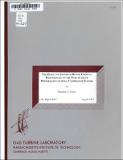| dc.contributor.author | Valkov, Theodore V. (Theodore Valkov) | en_US |
| dc.contributor.other | Massachusetts Institute of Technology. Gas Turbine Laboratory | en_US |
| dc.date.accessioned | 2016-10-06T21:22:30Z | |
| dc.date.available | 2016-10-06T21:22:30Z | |
| dc.date.issued | 1997 | en_US |
| dc.identifier.uri | http://hdl.handle.net/1721.1/104761 | |
| dc.description | August 1997 | en_US |
| dc.description | Includes bibliographical references (pages 121-130) | en_US |
| dc.description.abstract | Time-accurate Reynolds-averaged Navier-Stokes simulations have been carried out to investigate the impact of upstream rotor wakes and tip leakage vortices on the loss of a compressor stator. The objective is to (1) identify the unsteady flow mechanisms responsible for performance changes, (2) quantify these changes, and (3) extract useful design information. There are two generic mechanisms with significant impact on performance: reversible recovery of the energy in the disturbances (beneficial) and non-transitional boundary layer response (detrimental). For both wakes and tip leakage vortices, the impact of these mechanisms can be described in the same two-dimensional terms. In presence of unsteady flow, the efficiency of the design under consideration is 0.2 points higher than that obtained using a mixing-out steady flow approximation (0.5 points recovery benefit minus 0.3 points from boundary layer response). The effects of tip vortices and wakes are of comparable importance. | en_US |
| dc.description.abstract | The impact of stator interaction with upstream wakes and vortices depends on the following parameters: axial spacing, loading, aid the frequency of wake fluctuations in the rotor frame. At reduced spacing, this impact becomes significant. For a spacing of 0.07 chords, stage efficiency is 0.6 points higher relative to the steady flow (1.2 points recovery benefit minus 0.6 points from boundary layer response). About 1/2 to 2/3 of the efficiency gain observed experimentally can be attributed to the interaction with upstream wakes and vortices. In the relative frame, wakes fluctuate in time. For fluctuation frequencies between 0.3-0.8 times the blade passing frequency, recovery does not occur, and there is a significant difference between the effects of fluctuating and steady wakes (with the same ensemble-averaged properties). The most important aspect of the tip vortex is the velocity defect, which is perceived by the stator in the same manner as a wake. | en_US |
| dc.description.abstract | A model of recovery and boundary layer response in an embedded stage indicates that a mixing-out steady flow approximation underestimates stage efficiency by 0.3-0.5 points (for typical designs) and by 0.6-1.0 points (for closely-spaced blade rows). A region in design space exists where interaction has a beneficial and relatively constant impact on efficiency. Outside this region, interaction benefits rapidly disappear. For a typical blading diffusion factor of 0.45, the beneficial region is approximately delimited by the de Haller criterion. The detrimental aspects of boundary layer response may be mitigated by (a) selective removal of boundary layer fluid from the suction surface, or (b) tailoring of the blade loading to reduce loss in the front part of the blade. | en_US |
| dc.description.sponsorship | Sponsored by NASA Lewis Research Center | en_US |
| dc.format.extent | 268 pages | en_US |
| dc.publisher | Cambridge, Mass. : Gas Turbine Laboratory, Massachusetts Institute of Technology, 1997 | en_US |
| dc.relation.ispartofseries | GTL report #227 | en_US |
| dc.subject.lcc | TJ778.M41 G24 no.227 | en_US |
| dc.subject.lcsh | Compressors -- Blades | en_US |
| dc.subject.lcsh | Wakes (Fluid dynamics) | en_US |
| dc.title | The effect of upstream rotor vortical disturbances on the time-average performance of axial compressor stators | en_US |
| dc.type | Technical Report | en_US |
| dc.identifier.oclc | 38084136 | en_US |
